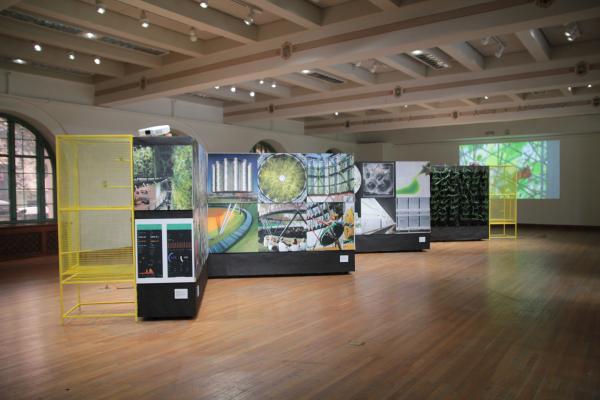OTHER NATURE Exhibit Explores New Approaches to Integrating Natural Systems into the Built Environment: On View through September 15

At their most basic level, buildings protect us from the sun, wind, and rain while comprising the very materials nature provides. This tendency to either shield from or consume the environment (without giving much back) typically contributes to an overt division, rather than synergy, between architecture and its surroundings. Nature, in this scenario, is “other.” It is relegated as outside, disregarded by human priorities for space.
For Associate Professor Danelle Briscoe, the visionary behind the OTHER NATURE exhibit, architectural projects should consider more than just human habitation. For her and the theorists and practitioners represented in the exhibit, new and inclusive approaches to integrating natural systems into the built environment with broader façade applications have the potential to mediate in the development of the Anthropocene and provide possible solutions for mitigating our current environmental crisis. These approaches include walls of planting, habitats for bees, and niches for growing algae. Empowering the “other” within the ordinary encourages ecological integration within the social and functional impacts of practice.
An outcome of Briscoe’s Meadows Foundation Centennial Fellowship at the Center for American Architecture and Design, the OTHER NATURE exhibit and accompanying book offer examples of systems and façade treatments that use vegetation as a thoughtful building material that connects people with their food and provides habitats for living creatures.
One such example is the UT School of Architecture’s Living Wall pilot project, envisioned and installed by Briscoe in Spring 2016 in collaboration with the Lady Bird Johnson Wildflower Center. Located along the northwest corner of Goldsmith Hall facing Guadalupe Street, the ten-by-twenty-five-foot Living Wall features a series of honeycomb-shaped components that house native plants and serve as a bio-habitat for anole lizards, birds, bees, and butterflies. Since its installation, Briscoe and other researchers have monitored the structure and gathered data on the flora and fauna and their viability in Austin’s hot, dry climate. From this data, the living wall can be said to help cool the building and serves as a natural air filter.
On view in the Mebane Gallery through September 15, the exhibition features eleven examples of ecological design in action, in addition to potential ways that the discipline and the academy can explore and effectively apply such design innovation. Work from the following practices is included: Diana Agrest, FAIA; Precht; Akihisa Hirata; Husos Architects; ecosistema urbano; Jardin Shinohara; Terreform ONE; Variance Design; Rael San Fratello; Danze Blood Architects; and ecoLogicStudio.
Accompanying the OTHER NATURE exhibition is a seventy-page book published by the Center for American Architecture and Design. In addition to photographic and video representation of the exhibited projects, the catalog features an in-depth interview with Diana Agrest, FAIA; a transcribed lecture by Dr. Claudia Pasquero of ecoLogicStudio; and playful pop-up spreads that complement the work of both Belinda Tato of ecosistema urbano and Dr. Mitchell Joachim, Assoc. AIA of Terreform ONE.
For more information about the book and to purchase a copy from the Center for American Architecture and Design, visit the School of Architecture website. The exhibit will be on view in the Mebane Gallery in Goldsmith Hall, Monday-Friday from 8:00 a.m. to 5:00 p.m. through September 15.

